by Alison Hugill // Nov. 19, 2024
This article is part of our feature topic Alien.
In October of this year, Palestinian-Danish artist Larissa Sansour opened her sweeping solo exhibition at Amos Rex in Helsinki. The thoroughly darkened underground space of the museum is a fitting location to show Sansour’s film-heavy body of work, spanning from 2009-2022, much of which is science-fictional in its storytelling. In the show, we encounter ethereal films and installations that speak to experiences of displacement and narratives of inherited trauma—themes that define much of Sansour’s practice.
The first film in the exhibition, ‘In Vitro’ (2019)—realized with creative partner Søren Lind for the Danish Pavilion at the Venice Biennale the same year—takes place in Bethlehem, in the aftermath of an ecological disaster. In it, the founder of a subterranean orchard, which will be replanted above ground by her successor when it’s safe to do so, is on her deathbed. The successor, a clone of the founder’s deceased daughter, was born and raised underground, and her memories of the distant past are those of the person she replaced and thus completely alien to her. Through this grief-laden tale, Sansour and Lind explore not only the potential effects of accelerated climate change, but also the experience of different forms of erasure inflicted on the Palestinian people and the more universal sense of alienation felt by anyone who is forcibly separated from their homeland.
For another work on view, ‘Archeology in Absentia’ (2016), Sansour has buried porcelain plates with traditional patterns on them in various locations across Palestine and Israel. In the installation at Amos Rex, she presents 10 bronze munitions with the coordinates of the buried items engraved on them, pointing to their future excavation and imminent historicization. Just as in her sculpture ‘Monument for Lost Time’ (2019), these chronicling gestures point to an insistence on being remembered, despite efforts to the contrary. We spoke to Sansour about the choice of setting these personal stories in speculative futures and the difficulty of living in the shadow of memories that were never truly one’s own.
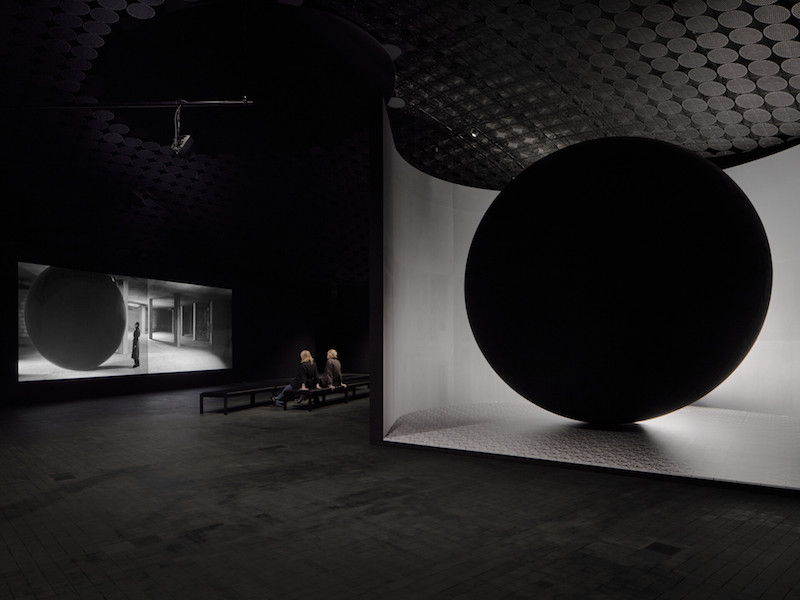
Larissa Sansour exhibition at Amos Rex, from left to right: Larissa Sansour: ‘In Vitro,’ 2019 and Larissa Sansour: ‘Monument for Lost Time,’ 2019 // Photo by Tuomas Uusheimo, courtesy of Amos Rex
Alison Hugill: I’d like to talk about your film ‘In Vitro,’ as well as the large-scale sculptural monolith ‘Monument for Lost Time’ that accompanies it—this alien object, which also appears in the film, stands as a spherical embodiment of the psychological effects of inherited trauma and epigenetics. Why have you chosen this otherworldly scenography and the aural and visual language of science fiction to speak about these personal and political themes?
Larissa Sansour: The Palestinian psyche is inextricable from its historical tragedy, and I am always trying to find ways in which to address trauma in my work. Palestinian identity seems to oscillate between lamenting the Nakba of 1948, where more than 700, 000 Palestinians were expelled from their land, and forecasting a future Palestinian state, with the present becoming increasingly elusive, especially with the incessant land grabs by the state of Israel.
Science fiction has the ability to absorb blurred temporalities, and I find that it fits well with the Palestinian issue. It is very hard to understand what’s happening on the ground now without understanding the historical context. Science fiction invariably carries with it a retro element that is difficult to shake off. If you try to format the future differently than it was previously visualized, it stops looking like the future. I find that the same logic applies to the Palestinian character. If tragedy is taken out of the equation, Palestinian identity would no longer be recognizable.
The large black sphere entitled ‘Monument for Lost Time’ is a way of referencing that void of the present—a present that functions as no more than a space of mourning and an anticipation for a better future. The sphere appears in ‘In Vitro’ as visual effect and is also extracted from that film to form a physical installation. I am interested in how objects acquire new meanings with this kind of shift in context. In the film, the sphere functions as a repository of inherited trauma and memories, just as it establishes a link between the past and future. Outside of the film, the sculpture is five meters in diameter and painted in the blackest of blacks, so as to not reflect any light. It is a signifier for a non-space, mimicking a black hole. As it doesn’t reflect any light, it loses its three-dimensionality and appears as a disc rather than a sphere, further problematizing the notion of space.
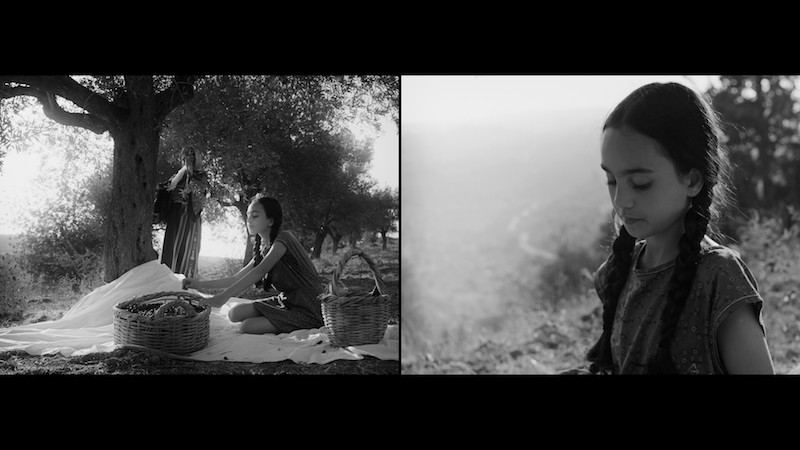
Larissa Sansour & Søren Lind: ‘In Vitro,’ 2019, film still // Courtesy of the artists
AH: The title, ‘In Vitro,’ speaks to being outside of a body—in glass or contained in an artificial womb. Can you talk about the choice of this title for your film?
LS: The film features a conversation between two people; Dunia, the dying founder of a group of scientists having sheltered themselves underground after an apocalypse, and Alia, a clone engineered from the remnants of Dunia’s deceased daughter. The underground compound houses an orchard based on heirloom seeds collected before the apocalypse, so the rehabilitation of the Palestinian flora is taking place outside of its natural habitat; in vitro. The same is the case for the cloned generation represented by Alia. Not only is she born and raised as a genetic replica in subterranean exile, she is also fitted with someone else’s memories of the past, so in terms of both body and mind, her being is manufactured in vitro. The film takes this artificiality as its starting point and addresses the complexity of our understanding of the distinction between reality and fiction.
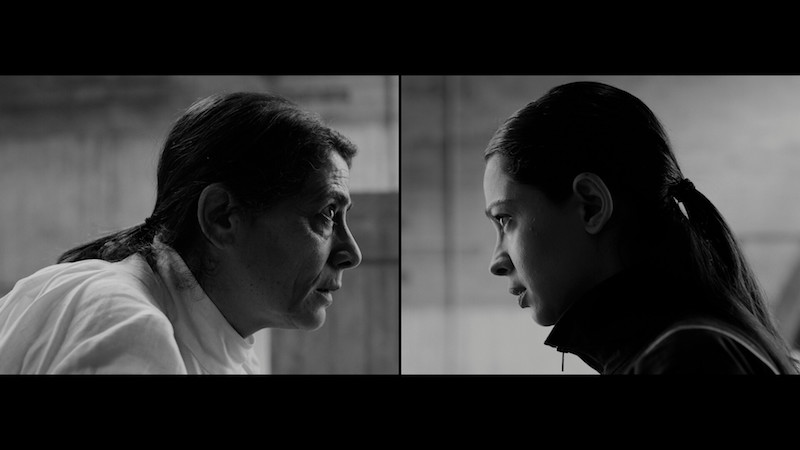
Larissa Sansour & Søren Lind: ‘In Vitro,’ 2019, film still // Courtesy of the artists
AH: At one point in the film, Alia seems overcome with emotion, talking about the difficulty of possessing memories that are not her own. How does her out-of-body experience in the film parallel that of someone living in the diaspora, whose homeland has been subjected to a state of ongoing disaster?
LS: One of the focal points of the film is the rift between the older generation born and raised in Bethlehem and the new generation only understanding the town through the memory of someone else, yet still being prompted to accept this town as their true place of belonging and the country as their homeland. This setup reflects the predicament of many Palestinians in the diaspora. They have never seen Palestine, but their memories of the place appear as real as those of their parents. Inherited trauma and epigenetics are elements that play a big part in the Palestinian disposition. And this automatic adoption of a homeland far away also exposes a conflict in the diasporic mind, the dismissal of their immediate present and surroundings as meaningful in themselves. Alia rejects the idea of the underground as nothing more than a waiting room, a place holder before the return. For Alia, the underground is her reality, it’s all she knows from personal experience, yet her implanted memories are forcing her to think otherwise.
This conflict is not only present in the diaspora abroad, but also internally in Palestine. I was born in Jerusalem, but after Israel built its segregation wall, I was no longer allowed to enter the city. A few years ago, I was given a permit to visit Jerusalem for the first time in 15 years, and I was overwhelmed by emotion as I realized that my memory had gradually suppressed the strong sense of belonging I used to have to that city and retrofitted a new reality matching the current restrictions on my mobility.
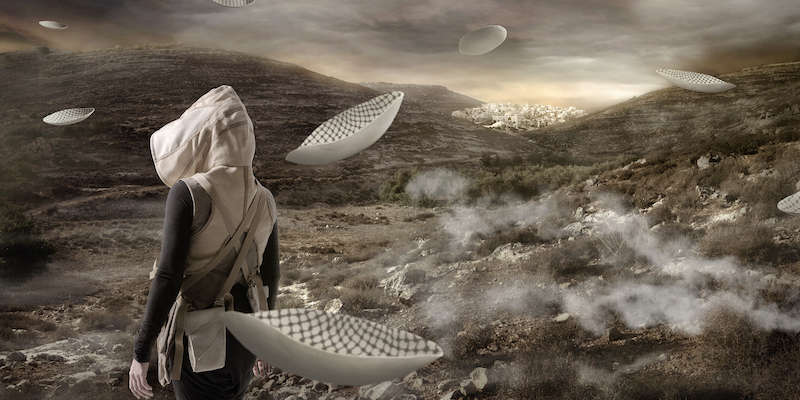
Larissa Sansour & Søren Lind: ‘In the Future They Ate from the Finest Porcelain,’ 2016, film still // Courtesy of the artists
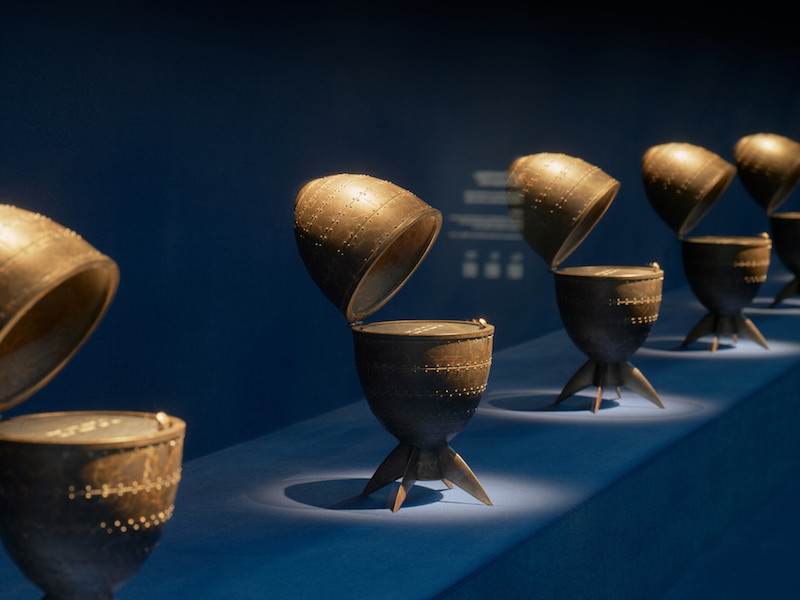
Larissa Sansour: ‘Archaeology in Absentia,’ 2016 // Photo by Tuomas Uusheimo, courtesy of Amos Rex
AH: In your project ‘Archeology in Absentia’ (2016), as well as ‘Monument for Lost Time,’ you seem to be planting something for future generations (or alien lifeforms) to find—a sign of life or proof of existence. What meaning does this kind of future-oriented historical intervention have for you today?
LS: It is exactly that, a historical intervention. Each of the 10 munitions point to a deposit of porcelain in Palestine that we buried as a performance, for future archaeologists to excavate. The work is closely linked to the film ‘In the Future They Ate from the Finest Porcelain,’ in which a rebel leader does the same, hoping to interfere with future understandings of history and eventually tilt the political balance in favour of her people. She specifically buries porcelain, as that material is foreign to the region and will force a reconsideration of the nature and diversity of the population, adding a new front in terms of legitimate claims to the land. This rebel leader calls herself a narrative terrorist, and this term is what the piece and related pieces are all about, the future dismantling of the historical narratives that keep the Palestinian people sectioned off somewhere outside of the regional history and chronology.
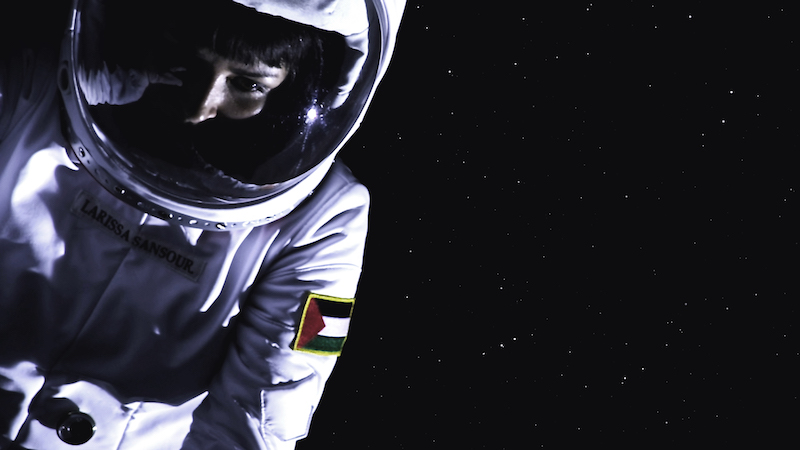
Larissa Sansour: ‘A Space Exodus,’ 2009 // Courtesy of the artist
AH: One of the last pieces on view and one of your earliest works in the show, ‘A Space Exodus’ (2009), features you dressed as an astronaut, the first Palestinian in space. Can you elaborate on the speculative idea of territory you’re enacting here and why you chose outer space as the frontier for this speculation?
LS: ‘A Space Exodus’ was my first ever sci-fi film and marked a significant shift in my practice. It’s essentially a film about land grab, displacement, national identity and mobility restrictions imposed on Palestinians by the Israeli occupation. The title re-appropriates the biblical exodus and sends the Palestinian people on a quest for a new homeland, eventually seeking refuge on the unpopulated moon—in reference to the phrase “A land without a people for a people without a land,” which is often cited in relation to the establishment of the state of Israel. ‘A Space Exodus’ is also a film about re-contextualizing, taking control of narrative and reframing perceptions by adopting a new language for addressing the Palestinian issue, no longer just the subject of documentaries, but now presented in a sci-fi format associated with technological advancement and accomplishment.
Exhibition Info
Amos Rex
‘Larissa Sansour’
Exhibition: Oct. 9, 2024-Mar. 2, 2025
amosrex.fi
Mannerheimintie 22-24, 00100 Helsinki, Finland, click here for map



















